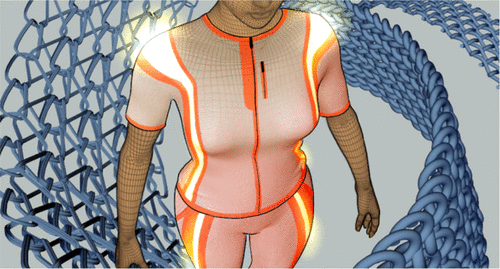当前位置:
X-MOL 学术
›
Acc. Chem. Res.
›
论文详情
Our official English website, www.x-mol.net, welcomes your feedback! (Note: you will need to create a separate account there.)
Wearable E-Textiles Using a Textile-Centric Design Approach
Accounts of Chemical Research ( IF 18.3 ) Pub Date : 2021-10-19 , DOI: 10.1021/acs.accounts.1c00433 Yunyun Wu 1 , Sara S Mechael 1 , Tricia Breen Carmichael 1
Accounts of Chemical Research ( IF 18.3 ) Pub Date : 2021-10-19 , DOI: 10.1021/acs.accounts.1c00433 Yunyun Wu 1 , Sara S Mechael 1 , Tricia Breen Carmichael 1
Affiliation

|
Electronics worn on the body have the potential to improve human health and the quality of life by monitoring vital signs and movements, displaying information, providing self-illumination for safety, and even providing new routes for personal expression through fashion. Textiles are a part of daily life in clothing, making them an ideal platform for wearable electronics. The acceptance of wearable e-textiles hinges on maintaining the properties of textiles that make them compatible with the human body. Beneficial properties such as softness, stretchability, drapability, and breathability come from the 3D fibrous structures of knitted and woven textiles. However, these structures also present considerable challenges for the fabrication of wearable e-textiles. Fabrication methods used for modern electronic devices are designed for 2D planar substrates and are mostly unsuitable for the complex 3D structures of textiles. There is thus an urgent need to develop fabrication methods specifically for e-textiles to advance wearable electronics. Solution-based fabrication methods are a promising approach to fabricating wearable e-textiles, especially considering that textiles have been successfully modified using pigmented dyes in dyebaths and printing inks for thousands of years. In this Account, we discuss our research on the solution-based electroless metallization of textiles to fabricate conductive e-textiles that are building blocks for e-textile devices. Electroless metallization solutions fully permeate textile structures to deposit metallic coatings on the surfaces of individual textile fibers, maintaining the inherent textile structures and wearability. The resulting e-textiles are highly conductive, soft, and stretchable. We furthermore discuss ways to turn the challenges related to textile structures into new opportunities by strategically using the structural features of textiles for e-textile device design. We demonstrate this textile-centric approach to designing e-textile devices using two examples. We discuss how the structure of an ultrasheer knitted textile forms a useful framework for new e-textile transparent conductive electrodes and describe the implementation of these electrodes to form highly stretchable light-emitting e-textiles. We also show how the structural features of velour fabrics form the basis for an innovative “island-bridge” strain-engineering structure that enables the integration of brittle electroactive materials and protects them from strain-induced damage, leading to the fabrication of stretchable textile-based lithium-ion battery electrodes. With the vast variety of textile structures available, we highlight the opportunities associated with this textile-centric design approach to advance textile-based wearable electronics. Such advances depend on a deep understanding of the relationship between the textile structure and the device requirements, which may potentially lead to the development of new textile structures customized to support specific devices. We conclude with a discussion of the challenges that remain for the future of e-textiles, including durability, sustainability, and the development of performance standards.
中文翻译:

使用以纺织品为中心的设计方法的可穿戴电子纺织品
佩戴在身体上的电子产品有可能通过监测生命体征和运动、显示信息、提供自发光以确保安全,甚至通过时尚为个人表达提供新途径,从而改善人类健康和生活质量。纺织品是服装日常生活的一部分,使它们成为可穿戴电子产品的理想平台。可穿戴电子纺织品的接受取决于保持纺织品的特性,使其与人体相容。针织和机织纺织品的 3D 纤维结构具有柔软性、拉伸性、悬垂性和透气性等有益特性。然而,这些结构也给可穿戴电子纺织品的制造带来了相当大的挑战。用于现代电子设备的制造方法专为 2D 平面基板而设计,大多不适用于纺织品的复杂 3D 结构。因此,迫切需要开发专门用于电子纺织品的制造方法,以推进可穿戴电子产品的发展。基于溶液的制造方法是制造可穿戴电子纺织品的一种很有前途的方法,特别是考虑到数千年来在染浴和印刷油墨中使用着色染料成功地改性纺织品。在这个帐户中,我们讨论了我们对纺织品的基于溶液的化学镀金属的研究,以制造作为电子纺织品设备构建块的导电电子纺织品。无电金属化解决方案完全渗透纺织结构,在单根纺织纤维的表面沉积金属涂层,保持固有的纺织结构和耐磨性。由此产生的电子纺织品具有高导电性、柔软性和可拉伸性。我们进一步讨论了通过战略性地将纺织品的结构特征用于电子纺织品设备设计,将与纺织品结构相关的挑战转化为新机遇的方法。我们使用两个示例展示了这种以纺织品为中心的设计电子纺织品设备的方法。我们讨论了超薄针织纺织品的结构如何为新型电子纺织品透明导电电极形成有用的框架,并描述了这些电极的实施以形成高度可拉伸的发光电子纺织品。我们还展示了丝绒织物的结构特征如何构成创新的“岛桥”应变工程结构的基础,该结构能够整合脆性电活性材料并保护它们免受应变引起的损伤,从而制造出可拉伸的纺织品——基于锂离子电池的电极。凭借种类繁多的纺织品结构,我们强调了与这种以纺织品为中心的设计方法相关的机会,以推进基于纺织品的可穿戴电子产品。这种进步取决于对纺织品结构与设备要求之间关系的深入理解,这可能会导致开发新的纺织品结构以支持特定设备。最后,我们讨论了电子纺织品未来仍存在的挑战,
更新日期:2021-11-03
中文翻译:

使用以纺织品为中心的设计方法的可穿戴电子纺织品
佩戴在身体上的电子产品有可能通过监测生命体征和运动、显示信息、提供自发光以确保安全,甚至通过时尚为个人表达提供新途径,从而改善人类健康和生活质量。纺织品是服装日常生活的一部分,使它们成为可穿戴电子产品的理想平台。可穿戴电子纺织品的接受取决于保持纺织品的特性,使其与人体相容。针织和机织纺织品的 3D 纤维结构具有柔软性、拉伸性、悬垂性和透气性等有益特性。然而,这些结构也给可穿戴电子纺织品的制造带来了相当大的挑战。用于现代电子设备的制造方法专为 2D 平面基板而设计,大多不适用于纺织品的复杂 3D 结构。因此,迫切需要开发专门用于电子纺织品的制造方法,以推进可穿戴电子产品的发展。基于溶液的制造方法是制造可穿戴电子纺织品的一种很有前途的方法,特别是考虑到数千年来在染浴和印刷油墨中使用着色染料成功地改性纺织品。在这个帐户中,我们讨论了我们对纺织品的基于溶液的化学镀金属的研究,以制造作为电子纺织品设备构建块的导电电子纺织品。无电金属化解决方案完全渗透纺织结构,在单根纺织纤维的表面沉积金属涂层,保持固有的纺织结构和耐磨性。由此产生的电子纺织品具有高导电性、柔软性和可拉伸性。我们进一步讨论了通过战略性地将纺织品的结构特征用于电子纺织品设备设计,将与纺织品结构相关的挑战转化为新机遇的方法。我们使用两个示例展示了这种以纺织品为中心的设计电子纺织品设备的方法。我们讨论了超薄针织纺织品的结构如何为新型电子纺织品透明导电电极形成有用的框架,并描述了这些电极的实施以形成高度可拉伸的发光电子纺织品。我们还展示了丝绒织物的结构特征如何构成创新的“岛桥”应变工程结构的基础,该结构能够整合脆性电活性材料并保护它们免受应变引起的损伤,从而制造出可拉伸的纺织品——基于锂离子电池的电极。凭借种类繁多的纺织品结构,我们强调了与这种以纺织品为中心的设计方法相关的机会,以推进基于纺织品的可穿戴电子产品。这种进步取决于对纺织品结构与设备要求之间关系的深入理解,这可能会导致开发新的纺织品结构以支持特定设备。最后,我们讨论了电子纺织品未来仍存在的挑战,


























 京公网安备 11010802027423号
京公网安备 11010802027423号